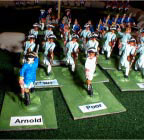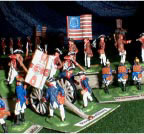 This is a revised version of a set of rules I wrote three years ago. The original version was published in The Volunteer. The rules were simplified and are now very similar to the rules I use for other battles. The rules for morale checks and charges were simplified.
This is a revised version of a set of rules I wrote three years ago. The original version was published in The Volunteer. The rules were simplified and are now very similar to the rules I use for other battles. The rules for morale checks and charges were simplified.
Historical Background
Everyone remembers that Benedict Arnold was a traitor during the Revolutionary War. What is often forgotten is that prior to his treachery he was America's finest general. Perhaps his greatest display of leadership and courage was at the second battle of Saratoga, also known as Bemis Heights. It was at this battle that Arnold led a successful American attack against a British fort. His victory eventually forced General Burgoyne to surrender his army, and gave the French the encouragement they needed to declare war on the British. It was the turning point in the war, and one of the most important battles in American History.
Battle 1
Morgan's rifles had successfully scouted the British lines and taken up a position in the woods on the British right flank. After receiving fire from the riflemen the British 24th foot lowered bayonets and went into the woods to drive them away. They scattered the riflemen, but soon found themselves swarmed by other American units. Only a handful of survivors made it back to the British lines. American reinforcements arrived, including the charismatic Gen. Arnold. Sadly, Arnold would spend the entire battle cowering in the rear, rather than leading from the front.
The Americans tried to use the forest as cover for a move around the British left flank. General Von Riedesel spotted the danger and led a strong British force to block the maneuver. His men stopped the American advance in its tracks and stood toe to toe with several units of Continental line, breaking them one by one. It was wearying work, however, and when the Albany Militia moved up and charged the British fled, much to the surprise of Gen. Von Riedesel. In the center the Americans were making steady progress, led by Gen. Poor's brigade. Poor's men captured two British field cannons, forcing their way through the British line of defense. With the sun going down Poor's brigade raced for the British redoubts. Unfortunately by the time they got to the abatis protecting the British redoubtss it was too late in the day to start an assault. The British had won the battle.
 Battle 2
Battle 2
At the start of the battle the Americans withdrew Morgan's Brigade to use as a reserve, under the command of Benedict Arnold, for the final assault on the British redoubts. The rest of the American army advanced in the center, and tried to turn the British left flank. The British mounted a series of brilliant counterattacks to stop the American advance in the center. This strategy came at a cost, however, as both General Von Riedesel and General Burgoyne became casualties. The Grenadiers, Rangers, and Indians volunteered to serve as a rearguard while the British withdrew to the redoubts. The Rangers and Indians ambushed the Americans trying to sneak through the woods on the British left flank, buying time for the British to begin their retreat. In the center the brave Grenadiers were slowly picked apart as their fellows retired to the safety of the redoubts. The British field cannons were unable to keep up with the retreating infantry, and all but two were overrun and captured by the advancing Americans.
The British right redoubt was too powerful for the Americans to attack, so they concentrated their attacks on the left redoubt. The Americans hacked their way through the abatis in the front of the redoubt, suffering terrible damage from the defenders. One brigade moved between the redoubts, suffering fire from both sides, so they could attack the rear. As the sun set in the West the Americans stormed the redoubt from two directions, leading to savage hand to hand fighting. The British drove back both assaults at a heavy cost. The final American assault, featuring Gen. Arnold and Morgan's Brigade, didn't arrive in time. The British were relieved to have won a narrow victory, although they lost General Burgoyne, their commander in chief.
Victory Conditions
The Americans must capture one of the British redoubts.
The Map
The board is 7.5' x 5' and mostly clear terrain.The American end of the board is surrounded on three sides by forest. This can be represented by felt, or outlined with marker. I placed lichen (from model railroad store) along the edges. There are two redoubts (crude forts) at the British end of the table. The redoubts should be surrounded by abatis (pointy stakes) and open at the back. The redoubts and abatis can be drawn in marker or mapped out with whatever materials you have available. Here's a section of pointy stakes you can print and use for the abatis. The British Recon force must start the game deployed in the clearing. The remaining British forces must start in one of the redoubts. Learned and Poor's brigades may start anywhere in the woods in front of the British, and Morgan's brigade may start in the woods on the right flank of the British.
Building the Armies
I used Imex's plastic 1/72 scale Revolutionary War figures. Unfortunately this set doesn't include any of the unusual units like Brunswickers, Grenadiers, etc. I fashioned crude versions of these figures by carving their hats with a sharp knife and the judicious use of paint. The field cannons were from Imex's civil war sets, the redoubt cannons from Revell's Thirty Years War Artillery set, and the crew were modified revolutionary war figures. I mounted the figure three to a base, although two would have been better. Commanders were mounted individually, and Benedict Arnold was a mounted figure. The bases were painted green to match the felt on the gaming table. Each base was then given a ID label using computer generated mailing labels. The labels were color coded by regiment using colored pencils. My flags came from Warflag (www.warflag.com). The flagstaffs were made from paperclips. All the continental line were painted in full uniforms to help distinguish them from the militia, who were painted in various civilian outfits. Here are some paper soldiers you can print and use.
Orders of Battle
The number of bases in each unit is indicated inside the parentheses.
British
Recon Force - Gen. Burgoyne
Right Wing - Gen. Fraser
Butler's Rangers & Indians (2)
British Light Infantry (6)
British 24th Foot (5)
2 Field Cannons
Left Wing - Gen. Von Riedesel
British Grenadiers (6)
Brunswick Von Spaeth Regiment (6)
2 Field Cannons
In Redoubts - von Breymann
Canadian Militia (2)
Brunswick Von Specht Regiment (5)
Brunswick Grenadiers (6)
2 Redoubt cannons
Americans
Morgan's Brigade - Daniel Morgan
Virginia Rifles (4)
Dearborn Light Infantry (4)
Learned's Brigade - Gen. Learned
2nd Mass (4)
8th Mass (4)
9th Mass (4)
NY Militia (4)
Poor's Brigade - Gen. Poor
1st NH (4)
2nd NH (4)
3rd NH (4)
1st NY (4)
2nd NY (4)
4th NY (4)
1st Conn Militia (4)
2nd Conn Militia (4)
Enter Turn Two:
Patterson's Brigade - Gen. Patterson
10th Mass (3)
11th Mass (3)
12th Mass (3)
14th Mass (3)
Glover's Brigade - Gen. Glover
1st Mass (3)
4th Mass (3)
13th Mass (3)
15th Mass (3)
2nd Albany Militia (3)
Duchess & Ulster Militia (3)
Gen. Benedict Arnold
Useful Resources
1776 - Wargaming Rules and a Guide to the American War of Independence by Jay Facciolo and Joe Miceli
"Saratoga Order of Battle" by Wesley A. Rogers, Citadel 1996
Sons of the Revolution, http://www.walika.com/sr/
Warflag, http://www.warflag.com/
Arnold's Finest Hour Battle of Saratoga 1777
- Historical Background and Set Up
Fast Play Rules for Students
Paper Soldiers and Saratoga (very slow: 369K)
Back to Table of Contents -- Junior General Report # 4
Back to Junior General Report List of Issues
Back to MagWeb.com Magazine List
© Copyright 2004 by Matt Fritz.
This article appears in MagWeb.com (Magazine Web) on the Internet World Wide Web. Other articles covering military history and related topics are available at http://www.magweb.com